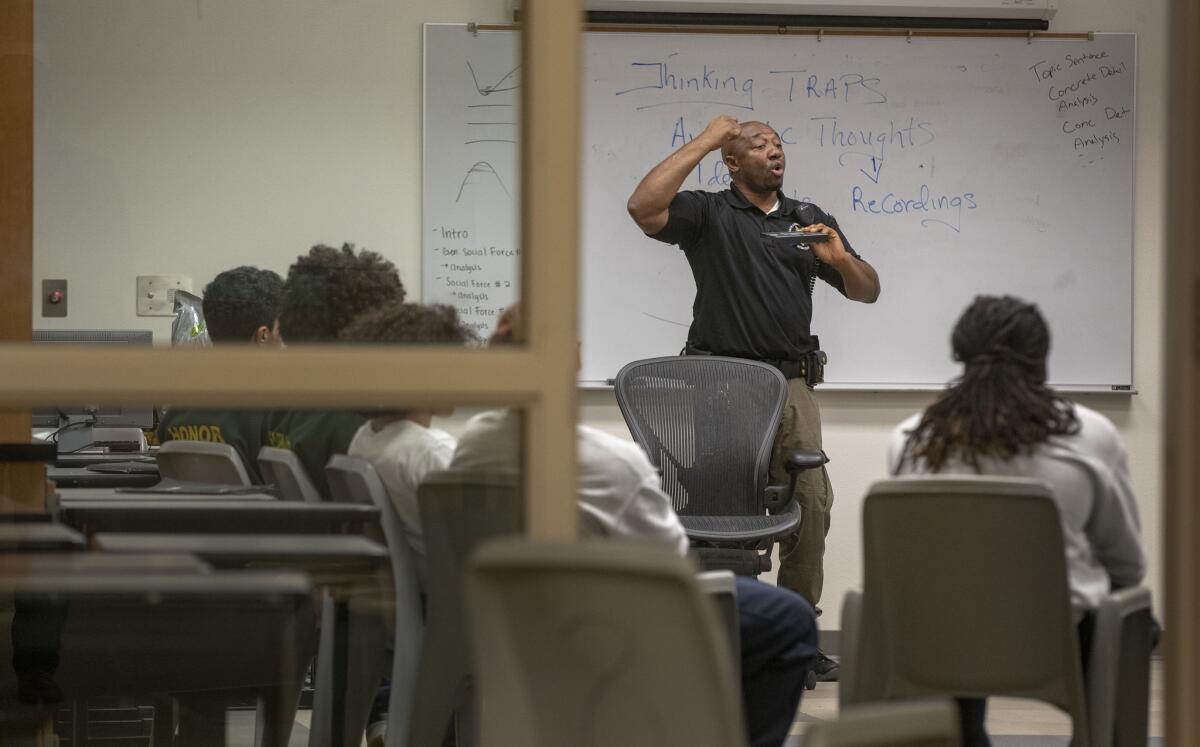Young offenders don’t belong in adult prisons. California has a chance to end the practice

- Share via
Adulthood doesn’t magically happen on the day someone turns 18. Any parent knows this, and numerous laws and social practices also recognize the fact.
The recently enacted federal budget, for example, bars youth under 21 from purchasing tobacco, something prohibited in California since 2016. California’s abused and neglected youth receive government help until age 21, and Californians under 21 are not allowed to consume alcohol or marijuana or purchase handguns in the state. Nationally, youth can stay on their parents’ health insurance until age 26 under the Affordable Care Act.
And have you ever stopped to consider why car insurance rates are so high for those under 25 and why many car rental agencies won’t rent to them? This is not due to soft-headed policymaking, but because hard-nosed actuarial analyses have found that emerging adults are higher-risk drivers.
In November, the group Chief Probation Officers of California proposed raising the age limit on California’s youth justice system from 18 to 20. The plan, if adopted, would make California the second state in the nation to recognize that young men and women, whether they’re 18 or 20, don’t belong in adult courts and correctional facilities. The probation chiefs are now looking for a legislative sponsor and vetting the idea with advocates, juvenile court judges, prosecutors and defenders. They could draft a bill for introduction this year.
The policy shift makes sense. We all want the same thing for youth who get into trouble with the law: a system that makes them less likely to re-offend and more likely to live happy, productive lives.
During late adolescence, youth form their understanding of themselves — and prison is no place to do that. Engaging them in education, community service and work with those their own age, rather than in an adult prison, has the potential to steer them toward more successful lives. The youth justice system, though imperfect, is a more developmentally appropriate alternative, with more rehabilitative off-ramps than the punishment-focused criminal justice system. Research from the Centers for Disease Control and Prevention found that juveniles under 18 who go through the youth justice system have lower re-arrest rates than similarly situated youths who are tried as adults.
A growing body of developmental psychology and brain research also shows that young adults’ brains haven’t finished developing and their personalities are changing, making them more amenable to rehabilitation.
Prison’s harmful effects particularly plague youth of color. While black men overall were incarcerated at six times the rate of white men in 2012, black men ages 18 and 19 were incarcerated at 9.5 times the rate of their white peers. And their history of incarceration then haunts them going forward, making it far more difficult to find housing and jobs.
The juvenile system, on the other hand, offers more confidentiality protections. Those who go through the system, if they stay out of trouble, can have records sealed, so youthful mistakes won’t dog them for the rest of their lives. They may still be tried as adults, but only if they commit serious offenses.
When America’s juvenile courts were launched in the early 1900s, they generally adopted age 18 as their upper limit because that’s when youth of that era stepped into adult roles like spouse, parent and worker. Research shows that marriage and work help young people grow out of youthful troublemaking, but today, emerging adults live in their family homes longer and complete their educations, go to work, and marry much later than previous generations. In 1960, for example, 45% of youth ages 18-24 were married; by the 2010 census, only 9% were.
Some have expressed concern that adding an influx of 18- to 21-year-olds to the state’s juvenile courts, probation and correctional facilities would overwhelm them. Indeed, last year in California, there were nearly as many felony arrest numbers for 18- and 19-year-olds (14,400) as for all youth ages 10 through 17 (17,200). But in states that have raised the age limit to 18 for those served by juvenile justice systems, such as New York and Massachusetts, the dire predictions of an overwhelmed system didn’t materialize, and juvenile court caseloads and detention populations actually declined.
To help address caseload concerns, the Chief Probation Officers’ proposal puts forth several ideas. I suggest adding a few more.
The officers’ group proposes terminating juvenile probation after one successful year and limiting probation conditions to only those related to public safety. These are good ideas whether or not the age is raised. The proposal could go further by automatically reducing probation terms by 30 days for every 30 days of good behavior (a provision pioneered successfully in Arizona, Louisiana and Missouri) and by increasing diversion mechanisms for less serious offenses. Both approaches have been shown to lower both recidivism rates and officer caseloads.
And to help prevent problems, raising the age to qualify for the youth justice system should be carefully planned, gradually phased in and properly funded, so the state maximizes its ability to turn young lives around.
It is right to kick the tires on the chiefs’ proposal. But in the final analysis, a proposal that increases the chance that young people graduate from the justice system and go on to live productive lives has the potential to improve the safety of all Californians.
Vincent Schiraldi is former commissioner of the New York City Department of Probation and co-director of the Columbia University Justice Lab.
More to Read
A cure for the common opinion
Get thought-provoking perspectives with our weekly newsletter.
You may occasionally receive promotional content from the Los Angeles Times.









